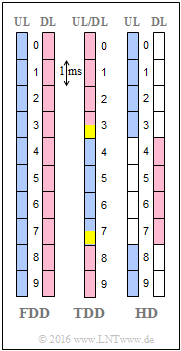Exercise 4.2: FDD, TDD and Half-Duplex
From LNTwww
Duplex processes are required in mobile radio to ensure that the uplink (UL) and downlink (DL) are clearly separated from each other and thus do not interfere with each other. According to the graphic, a distinction is made between
- Frequency Division Multiplex (FDD),
- Time Division Multiplex (TDD),
- Halb–Duplexverfahren (HD).
The first two duplex processes have already been used in UMTS .On the other hand, the half-duplex process is an innovation in Long Term Evolution (LTE).
Hinweis:
This task refers to the chapter Technische Neuerungen von LTE.
Questionnaire
Solution
(1) Correct is the solution 2:
- As shown in the graph on the data page, only one frequency band is sufficient for TTD.
- The other two duplex methods each require two frequency bands. In this context one also speaks of a "paired spectrum".
(2) At the same load of uplink and downlink, Frequency Division Duplex (FDD) is more favourable ⇒ solution 1:
- Although TDD requires only a single frequency band, only half of it can be used for uplink and downlink at the same load. Transmitter and receiver must therefore alternate during transmission.
- The main problem is the required, not always given synchronicity of the networks. In order to ensure largely undisturbed transmission even if synchronicity is not 100%, TDD requires guard periods between uplink and downlink use.
- The relative degradation of the TDD principle compared to FDD is quantitatively given by the percentage of yellow blocks at the same uplink and downlink load.
(3) The solutions 2 and 3 are applicable:
- A TDD terminal does not have to transmit and receive simultaneously and is therefore more cost-effective than an FDD terminal. The battery life is also longer.
- The TDD technique allows different modes that determine how much time should be used for downlink and uplink.
- Often the uplink requirements are much lower than the downlink requirements. With FDD there are many unused blue blocks in this case.
- Under this condition, the percentage degradation is reduced by the yellow Guard Periods. In the limit case "no uplink activity", the same number of downlink blocks could be transmitted as with FDD, but already at half the frequency bandwidth.
(4) Here the solutions 2 to 4 apply:
- Like FDD, half-duplex requires two frequency bands ⇒ a paired spectrum.Guard periods are therefore not required.
- Transmitter and receiver alternate with each other. This means that the terminal devices must also either only transmit or only receive, and are therefore more cost-effective.
- By a second connection to another terminal device with an interchanged downlink/uplink raster, the available paired band could be fully utilized.
